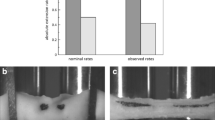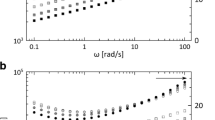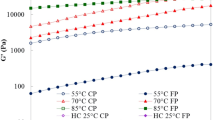Abstract
The in situ study of the linear viscoelastic behaviour of complex biological materials with changing volume, such as fermenting dough, poses great challenges to the rheologist. The aim of this study is to develop a new methodology involving a parallel-plate setup with an adjustable gap, to enable time-tracking of the dynamic moduli and density of fermenting dough. Frequency sweep snapshots at specific points in time were obtained in multiwave mode to reduce measurement times, and overfilling effects were taken into account by establishing a calibration curve with unfermented dough. The new test protocol allowed to distinguish the rheological impact of the CO2 gas from that of the other metabolites produced during fermentation. A further validation of the test protocol was achieved by studying the impact of sugar and salt on the fermentation kinetics, for which the results of the oscillatory tests were combined with gas production data obtained with a rheofermentometer.







Similar content being viewed by others
References
AACC International (2000) Approved methods of analysis, 11th. AACC International, St. Paul
Amemiya JI, Menjivar JA (1992) Comparison of small and large deformation measurements to characterize the rheology of wheat flour doughs. J Food Eng 16:91–108
AOAC International (1995) Official methods of analysis of AOAC international, 16th. AOAC, Washington
Angioloni A, Dalla Rosa M (2005) Dough thermo-mechanical properties: influence of sodium chloride, mixing time and equipment. J Cereal Sci 41:327–331
Aslankoohi E, Rezaei MN, Vervoort Y, Courtin CM, Verstrepen KJ (2015) Glycerol production by fermenting yeast cells is essential for optimal bread dough fermentation. PLoS ONE 10:e0119364
Baker JC., Mize MD (1941) The origin of the gas cell in bread dough. Cereal Chem 18:19–34
Beck M, Jekle M, Becker T (2012) Impact of sodium chloride on wheat flour dough for yeast-leavened products. I. Rheological attributes. J Sci Food Agric 92:585–592
Cauvain SP, Young LS (2007) Technology of breadmaking, 2nd edition. Springer, New York
Chevallier S, Zúñiga R, Le-Bail A (2012) Assessment of bread dough expansion during fermentation. Food and Bioprocess Technol 5:609–617
Czuchajowska Z, Pomeranz Y (1993) Gas formation and gas retention. I. The system and methodology. Cereal Foods World 38:499–503
Elmehdi HM, Page JH, Scanlon MG (2003) Monitoring dough fermentation using acoustic waves. Food and Bioproducts Process 81:217–223
Elmehdi HM, Page JH, Scanlon MG (2007) Evaluating dough density changes during fermentation by different techniques. Cereal Chem 84:250–252
Ewoldt RH, Johnston MT, Caretta LM (2015) Experimental challenges of shear rheology: how to avoid bad data. In: Spagnolie SE (ed) Complex fluids in biological systems. Springer Science+Business Media, New York
Harinder K, Bains GS (1990) High α-amylase flours: effect of pH, acid, and salt on the rheological properties of dough. Cereal Chem 67:588–594
He H, Roach RR, Hoseney RC (1992) Effect of nonchaotropic salts on flour bread-making properties. Cereal Chem 69:366–371
Hoseney RC, Hsu KH, Junge RC (1979) A simple spread test to measure the rheological properties of fermenting dough. Cereal Chem 56:141–143
Ito M, Yoshikawa S, Asami K, Hanai T (1992) Dielectric monitoring of gas production in fermenting bread dough. Cereal Chem 69:325–327
Jayaram VB, Cuyvers S, Lagrain B, Verstrepen KJ, Delcour JA, Courtin CM (2013) Mapping of Saccharomyces cerevisiae metabolites in fermenting wheat straight-dough reveals succinic acid as pH-determining factor. Food Chem 136:301–308
Jayaram VB, Rezaei MN, Cuyvers S, Verstrepen KJ, Delcour JA, Courtin CM (2014a) Ethanol at levels produced by Saccharomyces cerevisiae during wheat dough fermentation has a strong impact on dough properties. J Agric Food Chem 62:9326–9335
Jayaram VB, Cuyvers S, Verstrepen KJ, Delcour JA, Courtin CM (2014b) Succinic acid in levels produced by yeast (Saccharomyces cerevisiae) during fermentation strongly impacts wheat bread dough properties. Food Chem 151:421–428
Kilborn RH, Preston KR (1982) A modified extensigraph procedure for measuring the stretching properties of fermented dough. Cereal Chem 59:381–384
Koksel F, Scanlon MG, Page JH (2016) Ultrasound as a tool to study bubbles in dough and dough mechanical properties: a review. Food Res Int 89:74–89
Lee S, Pyrak-Nolte LJ, Campanella O (2004) Determination of ultrasonic-based rheological properties of dough during fermentation. J Texture Stud 35:33–52
Lee S, Campanella O (2013) Impulse viscoelastic characterization of wheat flour dough during fermentation. J Food Eng 118:266–270
Loveday SM, Winger RJ (2007) Mathematical model of sugar uptake in fermenting yeasted dough. J Agric Food Chem 55:6325–6329
Lynch EJ, Dal Bello F, Sheehan EM, Cashman KD, Arendt EK (2009) Fundamental studies on the reduction of salt on dough and bread characteristics. Food Res Int 42:885–891
McCann TH, Day L (2013) Effect of sodium chloride on gluten network formation, dough microstructure and rheology in relation to breadmaking. J Cereal Sci 57:444–452
McNaught AD, Wilkinson A (1997) Compendium of chemical terminology, 2nd. Blackwell Scientific Publications, Oxford
Meerts M, Cardinaels R, Oosterlinck F, Courtin CM, Moldenaers P (2017a) The interplay between the main flour constituents in the rheological behaviour of wheat flour dough. Food and Bioprocess Technol 10:249–265
Meerts M, Cardinaels R, Oosterlinck F, Courtin CM, Moldenaers P (2017b) The impact of water content and mixing time on the linear and non-linear rheology of wheat flour dough. Food Biophys 12:151–163
Meerts M, Ramirez Cervera A, Struyf N, Cardinaels R, Courtin CM, Moldenaers P (2018) The effects of yeast metabolites on the rheological behaviour of the dough matrix in fermented wheat flour dough. J Cereal Sci 82:183–189
Mert B (2008) A new instrumental setup for determination of small amplitude viscoelastic properties of dough during fermentation. Eur Food Res Technol 227:151–157
Miller RA, Hoseney RC (2008) Role of salt in baking. Cereal Foods World 53:4–6
Mora E, Artavia LD, Macosko CW (1991) Modulus development during reactive urethane foaming. J Rheol 35:921–940
Myers DK, Joseph VM, Pehm S, Galvagno M, Attfield PV (1998) Loading of Saccharomyces cerevisiae with glycerol leads to enhanced fermentation in sweet bread doughs. Food Microbiol 15:51–58
Neff RA, Macosko CW (1996) Simultaneous measurement of viscoelastic changes and cell opening during processing of flexible polyurethane foam. Rheol Acta 35:656–666
Nevoigt E, Stahl U (1997) Osmoregulation and glycerol metabolism in the yeast Saccharomyces cerevisiae. FEMS Microbiol Rev 21:231–241
Romano A, Toraldo G, Cavella S, Masi P (2007) Description of leavening of bread dough with mathematical modelling. J Food Eng 83:142–148
Salvador A, Sanz T, Fiszman SM (2006) Dynamic rheological characteristics of wheat flour-water doughs. Effect of adding NaCl, sucrose and yeast. Food Hydrocoll 20:780–786
Scanlon MG, Zghal MC (2001) Bread properties and crumb structure. Food Res Int 34:841–864
Skaf A, Nassar G, Lefebvre F, Nongaillard B (2009) A new acoustic technique to monitor bread dough during the fermentation phase. J Food Eng 93:365–378
Struyf N, Van der Maelen E, Hemdane S, Verspreet J, Verstrepen KJ, Courtin CM (2017) Bread dough and baker’s yeast: an uplifting synergy. Compr Rev Food Sci Food Saf 16:850–867
Verheyen C, Jekle M, Becker T (2014) Effects of Saccharomyces cerevisiae on the structural kinetics of wheat dough during fermentation. LWT Food Sci Technol 58:194–202
Verheyen C, Albrecht A, Herrmann J, Strobl M, Jekle M, Becker T (2015) The contribution of glutathione to the destabilizing effect of yeast on wheat dough. Food Chem 173:243–249
Wehrle K, Grau H, Arendt EK (1997) Effects of lactic acid, acetic acid, and table salt on fundamental rheological properties of wheat dough. Cereal Chem 74:739–744
Acknowledgments
Nore Struyf and Mohammad Naser Rezaei are gratefully acknowledged for determining the flour characteristics (protein content, moisture content, optimal mixing time and water absorption).
Funding
MM is indebted to the Research Foundation - Flanders (FWO) for a doctoral fellowship at KU Leuven. The authors would also like to express their gratitude to the Research Fund KU Leuven (IDO/12/011) for financial support.
Author information
Authors and Affiliations
Corresponding author
Additional information
Publisher’s Note
Springer Nature remains neutral with regard to jurisdictional claims in published maps and institutional affiliations.
Rights and permissions
About this article
Cite this article
Meerts, M., Vaes, D., Botteldoorn, S. et al. The time-dependent rheology of fermenting wheat flour dough: effects of salt and sugar. Rheol Acta 57, 813–827 (2018). https://doi.org/10.1007/s00397-018-1113-9
Received:
Revised:
Accepted:
Published:
Issue Date:
DOI: https://doi.org/10.1007/s00397-018-1113-9




